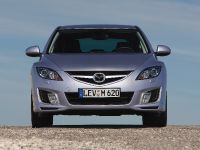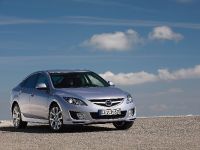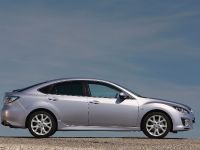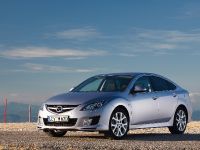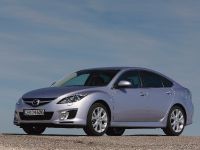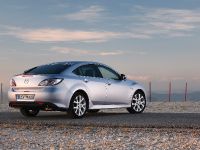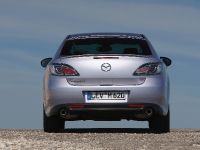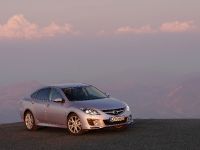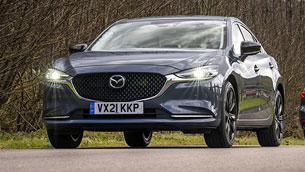Mazda6 New 2.2-litre Diesel Engine
New MZR-CD 2.2-litre Turbo Diesel Engine Next-generation MZR-CD 2.2-litre turbo diesel engine that combines Zoom-Zoom power with low emissions and low consumption
Offered in three power derivatives to meet the needs of a wide range of diesel customers in Europe (depending on market and grade):
- MZR-CD 2.2 High Power: produces 136 kW/185 PS at 3,500 rpm and 400 Nm of torque from 1,800 to 3,000 rpm, using only 5.6 litres (sedan and hatchback) and 5.7 litres (wagon) of fuel per 100 km (combined). Emits CO 2 of 149 g/km (sedan and hatchback) and 152 g/km (wagon)
- MZR-CD 2.2 Mid Power: produces 120 kW/163 PS at 3,500 rpm and 360 Nm of torque from 1,800 to 3,000 rpm, using only 5.5 litres (sedan and hatchback) and 5.6 litres (wagon) of fuel per 100 km (combined). Emits CO 2 of 147 g/km (sedan and hatchback) and 149 g/km (wagon)
- MZR-CD 2.2 Low Power: produces 92 kW/125 PS at 3,500 rpm and 310 Nm of torque at 1,800 to 2,600 rpm, using only 5.5 litres (sedan and hatchback) and 5.6 litres (wagon) of fuel per 100 km (combined). Emits CO 2 of 147 g/km (sedan and hatchback) and 149 g/km (wagon)
• New common-rail system with injectors that have 10 spray holes (instead of the 6 used on the MZR-CD 2.0-litre) and higher- response solenoids for power combined with low emissions • Common-rail injection pressure increased to 200 MPa, one of the industry's highest, with high-response solenoids, providing higher power, fuel efficiency and good emissions performance • Low compression ratio of 16.3:1, made possible with highly atomizing injectors, for temperature cooling effect which contributes to low consumption • Variable geometry, high-efficiency turbo charger with curved vanes and abradable seal for strong torque at low engine speeds and lively engine response • DOHC valve system is chain-driven for maintenance-free operation • High-rigidity aluminium lower block combined with low-friction, front chain-drive balancer shaft for low engine noise • Newly-developed, high thermal-resistance Mazda unique diesel particulate filter (DPF) system with global-first ceramic support matrix structure for faster regeneration • Newly-developed EGR cooler with superior cooling efficiency
New Rear Vehicle Monitoring System • First application among Japanese brands sold in Europe (depends on market and grade) • A fully independent active safety feature that detects and warns the driver of an approaching vehicle before he has a chance to change lanes by mistake • Uses two wide-angle, 24 GHz microwave radar units on the right and left side of the rear bumper to cover both sides of car within a range of about 50 m • Automatically calculates distance of the following vehicle, and its speed relative to the speed of the Mazda6 • Uses one of two ‘proximity indicator lights' in the inner garnish sails at the base of each A-pillar to warn the driver at approach of vehicle from left or right rear, or if a vehicle is already in the driver's blind spot • If the driver switches on the turn signal in the direction of the approaching vehicle, the proximity light blinks and a beeper sounds to warn the driver not to change lanes
Mazda6 Carry-Over Features
Other Powertrains • MZR 2.5-litre petrol engine produces maximum power of 125 kW/170 PS at 6,000 rpm and maximum torque of 226 Nm at 4,000 rpm • MZR 2.0-litre petrol produces 108 kW/147 PS at 6,500 rpm and maximum torque of 184 Nm at 4,000 rpm • MZR 1.8-litre petrol produces 88 kW/120 PS at 5,500 rpm and maximum torque of 165 Nm at 4,300 rpm • MZR-CD 2.0-litre turbo diesel remains in the line-up in some markets. It produces 103 kW/140 PS at 3,500 rpm and maximum torque of 330 Nm at 2,000 rpm. • Five and six-speed manual transmissions according to model, five-speed automatic with manual-shift mode for 2.0-litre petrol
Exterior • Eye-catching design based on Japanese aesthetics • Three distinct body styles – sedan, hatchback, wagon (depending on market) • One of the segment's lowest coefficient of drag, Cd 0.27 for sedan and hatchback and 0.28 for wagon • Minimal gaps between body panels reflect high quality • Rear lamps with LED standard in Europe • Choice of 16, 17 and 18-inch wheels • Sports appearance package is standard for sporty high-grade version
Interior • Floor console with sliding leather armrest (depending on grade) • More rear leg room (+ 20 mm) and shoulder room (+ 9 mm) for even more comfort • Optimal rearward visibility with special door mirror shapes and new rear head restraints • Gear shift lever placed closer to driver for easier shifting • Welcome mode with gradual illumination • Action illumination light system with fade in/out for audio commands
Chassis & Safety • Larger with more equipment than previous Mazda6, yet up to 35 kg lighter • Use of high and ultra-high strength steels • Higher flexural and torsional rigidity than any Mazda6 before it for improved handling and safety (sedan, 32% and 14% higher respectively) • High-mount double wishbone front suspension • E-type multilink rear suspension • Rack-drive electric power assist steering for a more firm steering feel and reduced fuel consumption • Improved active safety with large front disc brakes (299 mm) • ABS, electric brake distribution (EBD), brake assist, traction control system (TCS) and dynamic stability control (DSC) standard for all models • High-intensity Bi-xenon headlamps, Adaptive Front Lighting System, tyre pressure monitoring system and parking sensor system (optional) • Daytime running lights • Standard active front head restraints that lower the chance of neck injury during rear impact • Collapsible clutch and brake pedals for improved lower leg injury prevention • Front passenger, side and curtain airbags standard for all models • A further improvement of pedestrian protection including energy-absorbing space between the bonnet and the engine • Special foam in the bumper beam and plastic reinforcements at the bottom of the front bumper to help lower the chance of leg injuries
Equipment • Up to five equipment grades (depending on market) • Heating, ventilation and air conditioning (HVAC) system with separate controls for front seats (depending on grade) • Cross-functional network (CF-Net) in steering wheel enables more and easier control of audio, navigation, air-conditioning, trip computer and Bluetooth® system • Advanced Keyless Entry and Start System and push on/off ignition button (optional) • Bluetooth® mobile phone system with one-button (on steering wheel) operation in seven European languages (optional) • 8-speaker premium Bose® audio system with digital amplifying technology (optional) and AUX jack for MP3 players that use car's audio system • Navigation system with touch screen, voice command and a 7-inch split display (optional)
Mazda's New-Generation Powerful and Clean Diesel The second-generation Mazda6 was launched in November 2007 and represented an evolution of Mazda Zoom-Zoom. It set a new standard in the non-premium CD segment for its combination of eye-catching stylishness, exclusive driving experience and insightful packaging, all offered in three distinct body styles. Since launch, it has found over 85,000 owners in Europe and has been contributing to Mazda Motor Europe's record sales in 2008. Now the Mazda6 is about to get even more popular with the introduction of a new Mazda-developed 2.2-litre turbo diesel engine that is one of the quietest and most powerful in its segment and a new rear vehicle monitoring system for more active safety.
Mazda6 has always been a driver's car and with the launch of the new-generation model last year, the fun factor was improved even further. The second-generation Mazda6 was introduced originally with four different engines – three lively MZR petrol engines (in 2.5, 2.0 and 1.8-litre displacements) delivering power between 170 PS to 120 PS, and a MZR-CD 2.0-litre common-rail turbo diesel producing 140 PS and 330 Nm of torque. Mazda now introduces a new clean turbo diesel in three power derivatives that is one of the quietest and most powerful in its class.
Mazda's new MZR-CD 2.2-litre turbo diesel has a lively yet cultivated character that will offer a truly exclusive driving experience under the bonnet of the second-generation Mazda6. Offered in three versions producing 185, 163 and 125 PS of maximum output and powerful torque of 400, 360 and 310 Nm respectively, the MZR- CD 2.2 will meet the demands of a wide spectrum of customers in Europe.
Delivering the Power – Output and Torque To realise this kind of power and torque with 2.2-litres of displacement, the MZR-CD 2.2 employs a highly efficient variable-geometry turbo charger (VGT) with curved (instead of straight) vanes on the turbine (exhaust) side. This increases maximum available torque at both low and high engine speeds, while also increasing all-important low- end response (as low as only 1,800 rpm with a lat maximum torque curve that continues until 3,000 rpm) that contributes smooth and powerful driving feel. When combined with an abradable seal on the compressor side (intake side), which reduces the clearance between the blade and the compressor housing, these deliver superior turbocharger response at just about all engine speeds.
Converting the engine's combustion energy into this much engine torque meant the pistons had to be designed to take the resulting high combustion pressure and temperatures. As a consequence, the pistons are made of an aluminium alloy with improved high- temperature fatigue strength. A half-Keystone cross-section top- ring with improved carbon scavenging abilities is used, and the groove for the top ring is made more durable with the adoption of a cooled ring carrier that increases the groove's cooling capability.
Mazda engineers also increased the fuel injection pressure to 200 MPa (by comparison, the previous generation MZR-CD 2.0- litre turbo diesel uses 180 MPa). They realised this by making functional improvements to the high-pressure pump, among other improvements, and by new injectors featuring 10 spray holes per injector (instead of the 6 spray holes for the MZR-CD 2.0-litre) that are smaller (reduced from 0.13 mm to just 0.119 mm). These changes enable more precise injection timing, and an increase in the number of times of injection and injection amount. And it allowed the fuel injection patterns at transitional states to be more precisely controlled. As a result, the Mazda6 MZR-CD 2.2 provides superior acceleration in those situations you need it most, like entering the motorway. It also surpasses its competitors in lower speed acceleration. Acceleration in 3rd gear from 50 to 100 km/h, for example, is 1.7 seconds faster than the MZR-CD 2.0-litre.
Low Fuel Consumption This new diesel engine also meets the requirements of Mazda's ‘Sustainable Zoom-Zoom' plan by being frugal at the pump: all power derivatives use between 5.5 and 5.7 litres of fuel per 100 km (combined), some of the segment's lowest.
New injector with 10 spray holes
It achieves this by employing highly responsive solenoids for the common-rail injection system that achieve a minimum injection interval of just 0.2 ms (the MZR-CD 2.0 is 0.3 ms), which speeds up the minimum injection interval by about 30 percent, improves its responsiveness and lowers fuel usage. Fuel is also saved by lowering the compression ratio to 16.3:1 and utilizing the temperature cooling effect this causes, which secures more mixing time until ignition, and allows a more precise fuel-injection pattern. As a result, fuel consumption is a low 5.5 to 5.7 litres (depending on derivative) with CO 2 emissions from between 147 to 152 g/km. In fact, the MZR- CD 2.2-litre offers substantially higher power and torque than the previous-generation MZR-CD 2.0-litre, while delivering equal levels of fuel consumption and CO 2 emissions.
Low Emissions – Particulate Filter with World's First Ceramic Support Matrix Structure Mazda engineers not only made the new 2.2-litre turbo diesel powerful and low consumption, they also lowered the amount of raw emissions and raised the efficiency of its after-treatment technologies. The engine's highly responsive fuel-injection technologies have new injectors (see above) that yield better atomized spray characteristics. These are combined with an exhaust-gas recirculation (EGR) system with a cooler bypass structure – that decreases unburned gases and NOx – and the high- response solenoids described above, to realise superior emissions performance without sacrificing power.
Emissions are then treated by a diesel particulate filter that uses a unique Mazda-developed, ceramic support matrix structure, which is the first of its kind to go into production in the world. Previous diesel particulate filters converted particulate matter (PM) into CO 2 by reacting the PM with the oxygen in the exhaust gas at the surface of the catalytic particle. This meant that the time needed for filter regeneration was determined by the amount of oxygen on the surface of the catalyst.
When the temperature of the exhaust gas is raised to quicken the regeneration time, then technological issues – like higher fuel usage or the ceramics exceeding their thermal resistance limit – can occur. Mazda solved these issues by using highly thermal resistant material for the ceramic monolith of its new diesel particulate filter, and designing the internal structure of the ceramic support matrix with passages for oxygen to enable a large amount of oxygen to be utilized for PM combustion. With this, Mazda has succeeded in significantly increasing the PM combustion speed. As a result, the number of times the diesel particulate filter has to regenerate (in combined mode) is cut in half, and the time necessary for each regeneration phase is shortened by one third. For owners of the new Mazda6 MZR-CD 2.2-litre turbo diesel, this means worry-free filter regeneration and, because fewer regeneration phases are required and each takes less time, less fuel consumption overall.
Running Quiet The new Mazda6 MZR-CD 2.2-litre common-rail not only offers superior output, fuel economy and emissions performance, it is also one of the quietest engines in its segment with this amount of torque. This ensures a driving experience that is one of the non- premium segment's most exclusive. To achieve this, the new engine has a lower block with a very rigid aluminium-alloy structure, with the bottom of the cylinder block skirt and the cylinder block's main bearing caps bolted to the lower block at 18 separate locations. This high structural rigidity is combined with a front chain-driven cassette-type balancer shaft to suppress booming noise and lower radiated noise, and to deliver optimised pedal response and engine sound for a reined acceleration feel.
Balancer shafts
Packaging and Weight Management Keeping the new MZR-CD 2.2-litre engine as close as possible in size and weight to that of the MZR-CD 2.0-litre diesel was a key factor in ensuring exhilarating performance combined with fuel efficiency and low emissions. Some of the newly adopted technologies, such as the balancer shaft and DOHC, result in increased size and weight. Nonetheless, numerous innovations were added to manage size and weight increases, with the goal of maintaining packaging and keeping the weight increase within just 6.0 kg of the previous MZR- CD 2.0-litre turbo diesel.
Due to the increase in displacement, the stroke of the MZR-CD 2.2 was lengthened by 8 mm compared to the MZR-CD 2.0. At the same time, the overall length of the connecting rods was shortened by optimizing their design. As a result, their weight remains at the same level as in the MZR-CD 2.0. The adoption of a balancer shaft that decreases vibration caused by reciprocating motion made a thinner cylinder block with fewer ribs possible (if the MZR-CD 2.2 had no balancer shaft, the cylinder block would have been 1.9 kg heavier than that of MZR-CD 2.0, and its crankshaft 1.3 kg heavier.). Furthermore, decrease in size and weight was achieved by making the balancer housing, oil pump housing, and the oil suction pipe a single structure. To achieve even more weight reduction, while increasing the cooling capability of the new engine, the oil cooler is made of aluminium (-0.6 kg). The weight of the cam cover is also reduced by making it out of plastic (-1.0 kg).
Mazda6 – the first Mazda with Rear Vehicle Monitoring System Not only does the Mazda6 2.2-litre diesel meet the requirements of Mazda's ‘Sustainable Zoom-Zoom' strategy by delivering high power and torque with low consumption, it also meets the strategy's focus on improved safety by introducing a new vehicle monitoring system to the line-up as an enhancement to its already long list of active safety features. Employing two wide-angle, 24 GHz microwave radar units on the right and left side of the rear bumper, this system is a fully independent active safety feature that detects and warns the driver of an approaching vehicle - when driving at speeds over 60 kilometers per hour - before he has a chance to change lanes by mistake. It also detects vehicles driving in the blind spot area, and is effective even in bad weather conditions.
The light at the base of the A-pillar turns on when a vehicle approaches
Warns You if a Car approaches from the Left or Right Rear The two radar units are positioned to face outwards from the vehicle's centre line to cover the left and right lanes at the back of the car within a range of about 50 m. These radar units emit microwaves, which reflect off a following vehicle – including smaller vehicles like motorcycles – and are picked up again by the radar units in the bumper.
The Mazda6 system is outfitted with two ‘proximity indicator lights' placed in the inner garnish sails at the base of each A-pillar. These illuminate on the side where a car is detected approaching from behind. They blink (together with a beep sound) if the driver switches on the turn signal in the direction of the busy lane.
The system recognises the lanes on each side of the car independently or both at the same time when the lanes are full. It does not detect cars behind in the same lane.
Warns You before Changing Lanes If the system detects a car that is approximately 5 seconds away from reaching the Mazda6, it illuminates the proximity indicator light to warn the driver. If the approaching vehicle passes at a high speed, the proximity indicator will stay illuminated the entire time. Once the approaching vehicle completely passes the Mazda6 equipped with rear vehicle monitoring system, the light will turn off again.
If the driver switches on the turn signal in the direction of the approaching vehicle before it completely passes, the proximity light will blink and a beep sound will warn the driver not to change lanes. Mazda6 – Continued Excellence
Design – Japanese Aesthetics in Three Distinct Body Styles The Mazda6's athletic, sophisticated exterior design and high levels of build quality has been turning heads all over Europe since launch last year. Its exquisite sense of form based on Japanese aesthetics gives it a unique road presence that is distinctly Mazda.
The hatchback version is 4,735 mm long, 1,795 mm wide and 1,440 mm high and the sportiest-looking of the three versions with a sleek roofline at the C-pillar for a coupe-like image. The wagon is 4,765 mm long, 1,795 mm wide and 1,490 mm high and the longest of the three models, with a distinctive kick-up belt line and sleek windows for a cut through the wind look. And the sedan has the same exterior dimensions as the hatchback and offers customers the four-door + boot look of stylish quality and sophistication.
The dynamic and sleek exterior design of the Mazda6 also makes it one of the segment's most aerodynamic vehicles. All external components were streamlined to produce a coefficient of drag (Cd) of only 0.27 (sedan and hatchback) and just 0.28 (wagon), which contributes to stability at high speeds and an overall lowering of fuel consumption.
On the inside, Mazda6 was designed to take full advantage of the car's great looks, high quality and fun-to-drive character by delivering what engineers termed ‘Kizuna,' or a strong emotional bond between the car and its owner. Its wrap-around cockpit allows the driver to feel one with the car, and to fully enjoy an exquisite driving experience not usually found on cars in this class. The inside is not only attractive and roomy, with a floating-look dashboard that makes the inside seem even larger, it also has the highest levels of interior craftsmanship ever on a Mazda vehicle. This quality is underscored by interior forms that are appealing to look at and use on a daily basis.
Space, Comfort & Equipment – Easy to Use and Practical Though sporty-looking and sleek on the outside, the Mazda6 still provides more than enough family-sized space and practicality on the inside, which is especially important to CD segment customers. Compared to the previous model, the second-generation Mazda6 has 20 mm more rear leg room and 9 mm more rear shoulder room, which translates into more comfort precisely where it is needed – in the back seats. Customers also like the fact that it has one of the largest forward-upward views in the segment. When combined with specially designed rear head restraints and door mirrors that give the driver a better view to the rear, the Mazda6 is not only safer to drive, but easier to manoeuvre in tight spaces. To this it adds high levels of practicality with one of the segment's widest boot/ tailgate openings, Mazda's acclaimed Karakuri rear seat folding system that drops the 60/40 rear seats down by pulling a latch in the boot trim (hatchback and wagon), and a Karakuri tonneau cover that automatically lifts when you open and close the liftgate (wagon only).
Mazda6 is also designed with comfort in mind. It has specially formed seat frames for good long-trip comfort that also provide side support during sportier driving. And it makes the ride comfortable whatever the weather might be with a heating, ventilation and air conditioning (HVAC) system that has separate temperature controls for the driver and the passenger. The cockpit is also easy on the eyes with blackout driver metres (depending on grade) with amber- red illumination circled by indirect blue lighting, a new sports car- like steering wheel and gear shift lever positions that are closer to the driver for easier control and shifting. Mazda6 is also easy on the ears with a quiet driving experience, regardless of what engine is under the bonnet. Compared to the first-generation model, the Mazda6 is 2.5 dB (from 70 dB to 67.5 dB) quieter when driving at 60 km/h on a coarse road (see ‘Running Quiet' above for NVH measures on the new MZR-CD 2.2-litre diesel).
The new Mazda6 has plenty of convenient storage compartments that make it practical and easy-to-use on a daily basis. For small item storage there is a large glovebox, and a large centre console box – in dimpled-finished leather with a sliding armrest with leather stitching – that has cupholders in front. There are cupholders in the fold-out centre arm rest in the rear and front door trim pockets that can hold a 1.5-litre bottle and documents. Practical as well is the car's Action Illumination system with light fade up and down, and interactive light reaction when using the CD player and radio.
Up to five grades are available (depending on market) each with a long list of equipment, some onboard a Mazda for the very first time. There is more steering wheel control functionality (audio, navigation, air-conditioning, trip computer and Bluetooth® system) than ever before – a product of using a unique cross-functional network (CF-Net). A parking sensor system is available, a navigation system featuring a touch screen, voice command and a 7-inch split display (depending on market and grade), a Bluetooth® mobile phone system with seven languages, bi-xenon head lamps, adaptive front lighting system (AFS), a tyre pressure monitoring system and even a premium BOSE® audio system with eight speakers and AudioPilot® noise-compensation technology – just to mention a few. This is on top of a choice of 12 exterior colours, leather seats and an available sunroof.
Chassis & Safety – Sporty, Predictable and Safe The Mazda6 took Mazda's acclaimed steering and handling attributes to the next level at launch. Not only is the Mazda6 larger and better equipped than the previous-generation Mazda6, it is also lighter. This is the third vehicle – after the third-generation MX-5 and the new Mazda2 – to benefit from Mazda's ‘lightweight strategy' to lower weight and reduce fuel consumption. The Mazda6 body shell has 7 percent more high and ultra-high-strength steel than the previous Mazda6, which results in double-digit increases in both flexural and torsional rigidity for all body styles – without a gain in weight. This, along with weight savings at other locations, means today's Mazda6 is up to 35 kg lighter than its predecessor, has better handling and fuel efficiency, and enhanced crash resistance.
The front suspension is a high-mount double wishbone system that uses two additional perimeter frame mounting points (six vs. the four on the previous Mazda6), with dynamic dampers for the upper arms to absorb noise and vibrations, and stiff damper settings for excellent overall rigidity and ride comfort. This is combined with a single-pivot type lower arm, which gives more precise steering and predictability. Mazda's E-type multilink rear suspension is employed at the back axle with large-diameter trailing arm bushes placed 25 mm higher than those of the previous model to create a different geometry for improved rear lift control and a more linear toe-angle change during the rebound. The rear dampers are in an upright layout, which realises linear vehicle movement and a feeling of stability. Rack-drive electric power assist steering delivers a firm steering feel and contributes to lowering overall fuel consumption.
A long list of active and passive safety systems round out Mazda6's outstanding package of attributes. Besides an all-new rear vehicle monitoring system, Mazda6 also has an adaptive headlamp system that illuminates the curve when going around corners, Bi- xenon headlamps and a unique CF-NET, which allows minimal eye movement away from the road when using the vehicle systems. Added to this are large 299 mm ventilated front disc brakes and 280 mm rear brake discs for dependable deceleration; backed up by ABS, electronic brake distribution (EBD), brake assist, dynamic stability control (DSC) and a traction control system (TCS) as standard on all models.
The Mazda6 body shell is strong and very crash-resistance. It has a perimeter frame extension at the front of the car, and extended joints between the front side members of the perimeter frame, for a 10 percent improvement in impact-absorption here compared to the previous model. On the inside there are new active head restraints for the front seats to protect the neck in case of rear impact, six airbags, front seat belts with pretensioners and load-limiters and collapsible brake and clutch pedals to reduce the chance of leg injury in a frontal impact. Also onboard are ISOFIX child safety seat mounts and tethers in the outer rear seats, a visual seat belt warning system for rear passengers, pillar trim with energy absorbing ribs and a further improvement of pedestrian protection measures.
Technical DATA
Mazda6 MZR-CD 2.2-litre Turbo Diesel
| Sedan | Hatchback | Wagon | ||
| Body Type | Monocoque | Monocoque | Monocoque | |
| Doors | 4 | 4 + liftgate | 5 | |
| Seating capacity | 5 | 5 | 5 | |
| Coefficient of drag | Cd | 0.27 | 0.27 | 0.28 |
| Cross-sectional area | m2 | 2.19 | 2.19 | 2.19 |
| Boot Measurements | ||||
| Volume all seats up (VDA) | l | 519 | 510 | 519 |
| Volume 2nd row down | ||||
| (up to the roof) | l | --- | 1,702 | 1,751 |
| Load floor to 2nd row | mm | 1,096 | 1,071 | 1,119 |
| Load floor to 1st row | mm | --- | 1,879 | 1,926 |
| Boot lid / liftgate opening width | mm | 961 | 952 | 1,066 |
| Distance between | ||||
| rear wheel housings | mm | 1,000 | 1,000 | 1,030 |
| Boot load width at widest point | mm | 1,500 | 1,360 | 1,310 |
| Sedan | ||
| Dimensions | ||
| External | ||
| A Overalllengthw/without plateholder | mm | 4,755 / 4,735 |
| B Overall width | mm | 1,795 |
| C Overall width mirror to mirror | mm | 1,998 |
| D Overall height | mm | 1,440 |
| E Wheelbase | mm | 2,725 |
| F Trackfront | mm | 1,570*/1,560**/1,550*** |
| G Trackrear | mm | 1,570*/1,560**/1,550*** |
| H Ground clearance | mm | 165 |
| Interior | ||
| I Front head room w/o sunroof | mm | 1,001 |
| J Rear head room w/o sunroof | mm | 955 |
| K Front shoulder room | mm | 1,430 |
| L Rear shoulder room | mm | 1,410 |
| M Front leg room | mm | 1,079 |
| N Rear leg room | mm | 947 |
| O Rear knee clearance | mm | 44 |
* with 16 x 6J steel wheels ** with 16 x 6.5J alloy wheels *** with 17"/18" alloy wheels
| Hatchback | ||
| Dimensions | ||
| External | ||
| A Overalllengthw/without plateholder | mm | 4,755 / 4,735 |
| B Overall width | mm | 1,795 |
| C Overall width mirror to mirror | mm | 1,998 |
| D Overall height | mm | 1,440 |
| E Wheelbase | mm | 2,725 |
| F Trackfront | mm | 1,570*/1,560**/1,550*** |
| G Trackrear | mm | 1,570*/1,560**/1,550*** |
| H Ground clearance | mm | 165 |
| Interior | ||
| I Front head room w/o sunroof | mm | 1,001 |
| J Rear head room w/o sunroof | mm | 945 |
| K Front shoulder room | mm | 1,430 |
| L Rear shoulder room | mm | 1,410 |
| M Front leg room | mm | 1,079 |
| N Rear leg room | mm | 947 |
| O Rear knee clearance | mm | 44 |
* with 16x6J steel wheels ** with 16x6.5J alloy wheels *** with 17"/18" alloy wheels
| Wagon | ||
| Dimensions | ||
| External | ||
| A Overalllengthw/without plateholder | mm | 4,785/4,765 |
| B Overall width | mm | 1,795 |
| C Overall width mirror to mirror | mm | 1,998 |
| D Overall height | mm | 1,490* |
| E Wheelbase | mm | 2,725 |
| F Trackfront | mm | 1,570**/1,560***/1,550**** |
| G Trackrear | mm | 1,570**/1,560***/1,550**** |
| H Ground clearance | mm | 165 |
| Interior | ||
| I Front head room w/o sunroof | mm | 1,001 |
| J Rear head room w/o sunroof | mm | 990 |
| K Front shoulder room | mm | 1,430 |
| L Rear shoulder room | mm | 1,410 |
| M Front leg room | mm | 1,079 |
| N Rear leg room | mm | 947 |
| O Rear knee clearance | mm | 44 |
* including roof rails ** with 16 x 6J steel wheels *** with 16 x 6.5J alloy wheels **** with 17" and 18" alloy wheels
Mazda6 MZR-CD 2.2-litre Turbo Diesel High Power - Engine & Chassis
| MZR-CD 2.2 | ||
| High Power | ||
| Engine Type | In-line 4-Cylinder DOHC, 16-Valve | |
| Turbo-charged diesel | ||
| Displacement | cm3 | 2,184 |
| Bore x stroke | mm | 86 x 94 |
| Valves | 4 | |
| Camshaft drive | Chain | |
| Fuel injection system | Electrically controlled direct-injection | |
| Common-rail | ||
| Compression ratio | 16.3 : 1 | |
| Emission control system | Electrically controlled with catalyst and diesel | |
| particulate filter system | ||
| Max. power | kW | 136 at 3,500 rpm |
| PS | 185 at 3,500 rpm | |
| Max. torque | Nm | 400 at 1,800 to 3,000 rpm |
| Fuel type | ||
| Diesel Fuel tank capacity | l | 64 |
| Engine oil capacity | l | 4.7 with oil filter |
| Battery | 95D31L | |
| Transmission | 6-speed manual | |
| Powertrain | Front-wheel drive | |
| Gear ratios | ||
| 1st | 3.538 | |
| 2nd | 1.913 | |
| 3rd | 1.290 | |
| 4th | 0.926 | |
| 5th | 0.853 | |
| 6th | 0.711 | |
| Reverse | 3.831 | |
| Final Drive Ratio (1st – 4th)/ | ||
| (5th, 6th, Rev.) | 3.611/3.095 |
| MZR-CD 2.2 | ||
| High Power | ||
| Suspension and Wheels | ||
| Front suspension | Double wishbone | |
| Rear suspension | Multilink | |
| Damper front | Twintube | |
| Damper rear | Twintube | |
| Stabilizers (front / rear) | mm | 23/21 |
| Wheel size | inch | 17 - 18 |
| Tyre size | 215/50R17 - 225/45R18 | |
| Steering | ||
| Type | Rack and pinion | |
| electric power assist | ||
| Steering wheel turns (lock to lock) | 2.76 | |
| Turning circle (curb to curb) | m | 11.4 |
| Turning circle (wall to wall) | m | 11.8 |
| Brakes | ||
| Type front | Ventilated discs | |
| Type rear Discs | ||
| Diameter front | mm | 299 |
| Diameter rear | mm | 280 |
| Vacuum booster diameter | inch | 10 |
| Scheduled maintenance | Every 20,000 km /12 months |
Mazda6 MZR-CD 2.2-litre Turbo Diesel Mid Power - Engine & Chassis
| MZR-CD 2.2 | ||
| Mid Power | ||
| Engine Type | In-line 4-Cylinder DOHC, 16-Valve | |
| Turbo-charged diesel | ||
| Displacement | cm3 | 2,184 |
| Bore x stroke | mm | 86 x 94 |
| Valves | 4 | |
| Camshaft drive | ||
| Fuel injection system | Electrically controlled direct-injection | |
| Common-rail | ||
| Compression ratio | 16.3 : 1 | |
| Emission control system | Electrically controlled with catalyst and diesel | |
| particulate filter system | ||
| Max. power | kW | 120 at 3,500 rpm |
| PS | 163 at 3,500 rpm | |
| Max. torque | Nm | 360 at 1,800 to 3,000 rpm |
| Fuel type Diesel Fuel tank capacity | l | 64 |
| Engine oil capacity | l | 4.7 with oil filter |
| Battery | 95D31L | |
| Transmission | 6-speed manual | |
| Powertrain | Front-wheel drive | |
| Gear ratios | ||
| 1st | 3.538 | |
| 2nd | 1.913 | |
| 3rd | 1.290 | |
| 4th | 0.926 | |
| 5th | 0.853 | |
| 6th | 0.711 | |
| Reverse | 3.831 | |
| Final Drive Ratio (1st – 4th)/ | ||
| (5th, 6th, Rev.) | 3.611/3.095 |
| MZR-CD 2.2 | ||
| Mid Power | ||
| Suspension and Wheels | ||
| Front suspension | Double wishbone | |
| Rear suspension | Multilink | |
| Damper front | Twintube | |
| Damper rear | Twintube | |
| Stabilizers (front / rear) | mm | 23/21 |
| Wheel size | inch | 17 - 18 |
| Tyre size | 215/50R17 - 225/45R18 | |
| Steering | ||
| Type | Rack and pinion | |
| electric power assist | ||
| Steering wheel turns (lock to lock) | 2.76 | |
| Turning circle (curb to curb) | m | 11.4 |
| Turning circle (wall to wall) | m | 11.8 |
| Brakes | ||
| Type front | Ventilated discs | |
| Type rear Discs Diameter front | mm | 299 |
| Diameter rear | mm | 280 |
| Vacuum booster diameter | inch | 10 |
| Scheduled maintenance | Every 20,000 km /12 months |
Mazda6 MZR-CD 2.2-litre Turbo Diesel Low Power - Engine & Chassis
| MZR-CD 2.2 | ||
| Low Power | ||
| Engine Type | In-line 4-Cylinder DOHC, 16-Valve | |
| Turbo-charged diesel | ||
| Displacement | cm3 | 2,184 |
| Bore x stroke | mm | 86 x 94 |
| Valves | 4 | |
| Camshaft drive | Chain | |
| Fuel injection system | Electrically controlled direct-injection | |
| Common-rail | ||
| Compression ratio | 16.3 : 1 | |
| Emission control system | Electrically controlled with catalyst and diesel | |
| particulate filter system | ||
| Max. power | kW | 92 at 3,500 rpm |
| PS | 125 at 3,500 rpm | |
| Max. torque | Nm | 310 at 1,800 to 2,600 rpm |
| Fuel type | Diesel | |
| Fuel tank capacity | l | 64 |
| Engine oil capacity | l | 4.7 with oil filter |
| Battery 95D31L | ||
| Transmission | 6-speed manual | |
| Powertrain | Front-wheel drive | |
| Gear ratios | ||
| 1st | 3.538 | |
| 2nd | 1.913 | |
| 3rd | 1.290 | |
| 4th | 0.926 | |
| 5th | 0.853 | |
| 6th | 0.711 | |
| Reverse | 3.831 | |
| Final Drive Ratio (1st – 4th)/ | ||
| (5th, 6th, Rev.) | 3.611/3.095 |
| MZR-CD 2.2 | ||
| Low Power | ||
| Suspension and Wheels | ||
| Front suspension | Double wishbone | |
| Rear suspension | Multilink | |
| Damper front | Twintube | |
| Damper rear | Twintube | |
| Stabilizers (front / rear) | mm | 23/21 |
| Wheel size | inch | 16 - 17 |
| Tyre size | 205/60R16 - 215/50R17 | |
| Steering | ||
| Type Rack and pinion | ||
| electric power assist | ||
| Steering wheel turns (lock to lock) | 2.76 | |
| Turning circle (curb to curb) | m | 11.4 |
| Turning circle (wall to wall) | m | 11.8 |
| Brakes | ||
| Type front Ventilated discs | ||
| Type rear Discs | ||
| Diameter front | mm | 299 |
| Diameter rear | mm | 280 |
| Vacuum booster diameter | inch | 10 |
| Scheduled maintenance | Every 20,000 km /12 months |
Mazda6 MZR-CD 2.2-litre Turbo Diesel Sedan - Performance and Weights
| MZR-CD 2.2 | MZR-CD 2.2 | MZR-CD 2.2 | ||
| High Power | Mid-Power | Low Power | ||
| 6-speed manual | 6-speed manual | 6-speed manual | ||
| Performance | ||||
| Top speed | km/h | 218 | 212 | 195 |
| Acceleration 0-100 km/h* | s | 8.3 | 9.0 | 10.6 |
| Fuel Consumption** | ||||
| Urban | l/100 km | 7.1 | 7.0 | 7.0 |
| Extra urban | l/100 km | 4.7 | 4.7 | 4.7 |
| Combined | l/100 km | 5.6 | 5.5 | 5.5 |
| CO 2 emissions (combined) | g/km | 149 | 147 | 147 |
| Emissions ranking | Euro Stage IV | Euro Stage IV | Euro Stage IV | |
| Weight and Payload | ||||
| Min, kerb weight | ||||
| (without driver) | kg | 1,455 | 1,445 | 1,445 |
| Min. kerb weight*** | kg | 1,530 | 1,520 | 1,520 |
| Max. permissible weight | kg | 2,065 | 2,055 | 2,055 |
| Permissible front axle weight | kg | 1,180 | 1,170 | 1,170 |
| Permissible rear axle weight | kg | 985 | 985 | 985 |
| Permissible tow weight, | ||||
| trailer without brakes | kg | 550 | 550 | 550 |
| Permissible tow weight, | ||||
| trailer with brakes | ||||
| (12% slope) | kg | 1,600 | 1,600 | 1,600 |
| Max. roof load capacity | kg | 100 | 100 | 100 |
* Under Mazda test conditions
** According to 80/1268/EEC in its latest version
*** According to 92/21/EEC in its latest version (including 75 kg driver)
Mazda6 MZR-CD 2.2-litre Turbo Diesel Hatchback – Performance and Weights
| MZR-CD 2.2 | MZR-CD 2.2 | MZR-CD 2.2 | ||
| High Power | Mid-Power | Low Power | ||
| 6-speed manual | 6-speed manual | 6-speed manual | ||
| Performance | ||||
| Top speed | km/h | 218 | 212 | 195 |
| Acceleration 0-100 km/h* | s | 8.3 | 9.0 | 10.6 |
| Fuel Consumption** | ||||
| Urban | l/100 km | 7.1 | 7.0 | 7.0 |
| Extra urban | l/100 km | 4.7 | 4.7 | 4.7 |
| Combined | l/100 km | 5.6 | 5.5 | 5.5 |
| CO 2 emissions (combined) | g/km | 149 | 147 | 147 |
| Emissions ranking | Euro Stage IV | Euro Stage IV | Euro Stage IV | |
| Weight and Payload | ||||
| Min. kerb weight | ||||
| (without driver) | kg | 1,495 | 1,485 | 1,485 |
| Min. kerb weight*** | kg | 1,570 | 1,560 | 1,560 |
| Max. permissible weight | kg | 2,110 | 2,100 | 2,100 |
| Permissible front axle weight | kg | 1,180 | 1,170 | 1,170 |
| Permissible rear axle weight | kg | 1,030 | 1,030 | 1,030 |
| Permissible tow weight, | ||||
| trailer without brakes | kg | 550 | 550 | 550 |
| Permissible tow weight, | ||||
| trailer with brakes | ||||
| (12% slope) | kg | 1,600 | 1,600 | 1,600 |
| Max. roof load capacity | kg | 100 | 100 | 100 |
* Under Mazda test conditions
** According to 80/1268/EEC in its latest version
*** According to 92/21/EEC in its latest version (including 75 kg driver)
Mazda6 MZR-CD 2.2-litre Turbo Diesel Wagon – Performance and Weights
| MZR-CD 2.2 DE | MZR-CD 2.2 DE | MZR-CD 2.2 DE | ||
| High Power | Mid-Power | Low Power | ||
| 6-speed manual | 6-speed manual | 6-speed manual | ||
| Performance | ||||
| Top speed | km/h | 216 | 210 | 192 |
| Acceleration 0-100 km/h* | s | 8.5 | 9.2 | 10.8 |
| Fuel Consumption** | ||||
| Urban | l/100 km | 7.2 | 7.0 | 7.0 |
| Extra urban | l/100 km | 4.8 | 4.8 | 4.8 |
| Combined | l/100 km | 5.7 | 5.6 | 5.6 |
| CO 2 emissions (combined) | g/km | 152 | 149 | 149 |
| Emissions ranking | Euro Stage IV | Euro Stage IV | Euro Stage IV | |
| Weight and Payload | ||||
| Min. kerb weight | ||||
| (without driver) | kg | 1,510 | 1,500 | 1,500 |
| Min. kerb weight*** | kg | 1,585 | 1,575 | 1,575 |
| Max. permissible weight | kg | 2,145 | 2,135 | 2,135 |
| Permissible front axle weight | kg | 1,165 | 1,155 | 1,155 |
| Permissible rear axle weight | kg | 1,075 | 1,075 | 1,075 |
| Permissible tow weight, | ||||
| trailer without brakes | kg | 550 | 550 | 550 |
| Permissible tow weight, | ||||
| trailer with brakes | ||||
| (12% slope) | kg | 1,600 | 1,600 | 1,600 |
| Max. roof load capacity | kg | 100 | 100 | 100 |
* Under Mazda test conditions
** According to 80/1268/EEC in its latest version
*** According to 92/21/EEC in its latest version (including 75 kg driver)
